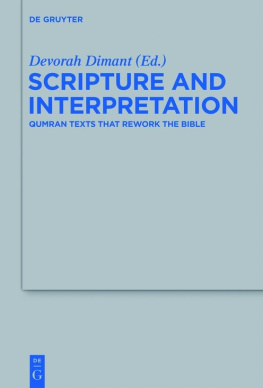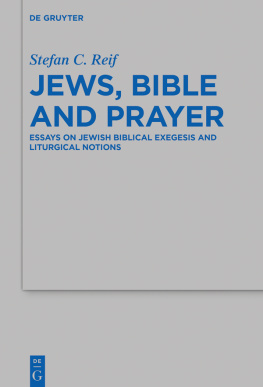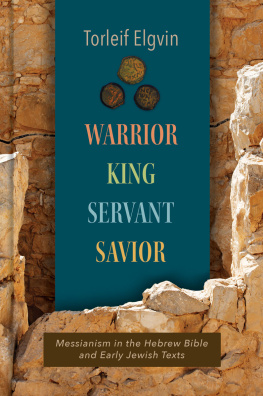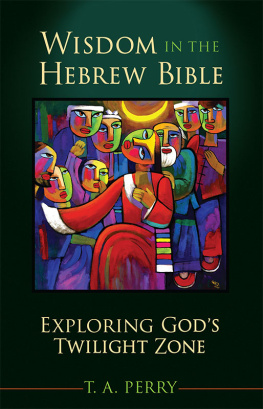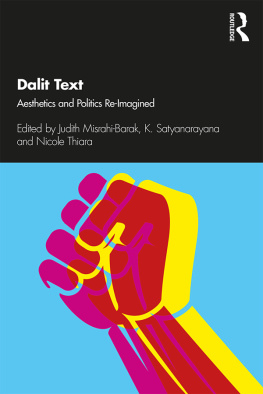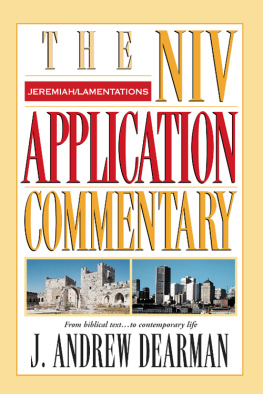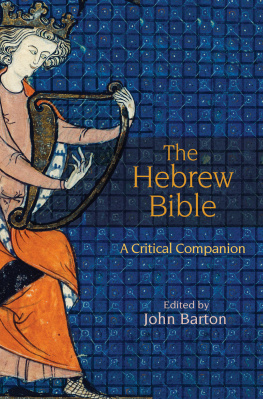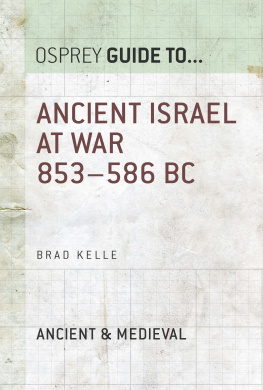How is it that some biblical texts justify Gods role in the Babylonian destruction of Judah, while others protest Gods actions, and others cast doubt on Gods justice in light of these events? If you want a compelling treatment that is careful to let the diverse biblical texts speak for themselves, look no further than Voices from the Ruins . Rather than viewing the diversity of biblical perspectives as problematic, Dalit Rom-Shilonis careful analysis surprisingly reveals that diverse theological pluralism is an essential characteristic of biblical texts as Gods people struggled to hold together their conceptions of divine justice, human responsibility, and divine mercy. Students and scholars alike stand to benefit from a careful reading of this insightful treatment of the biblical texts.
P AUL S. E VANS
McMaster Divinity College
Dalit Rom-Shiloni, in Voices from the Ruins , makes a significant contribution to the field of biblical theology. With a close and probing examination of texts in Jeremiah, Ezekiel, Psalms, and Lamentations, she focuses on how ancient Judeans grappled with the questions of divine power, presence, and fidelity, in relation to the destruction of Jerusalem in 587/586 BCE. Is G-d powerful, present, and trustworthy? These texts attempt to answer in the affirmative even as they recognize that G-d had failed to protect Jerusalem and Judah as promised. Her study is relevant for understanding divine presence, power, and fidelity in the present, too, as we moderns come to grips with questions raised by the Shoah (Holocaust), as well as justice and righteousness in our own contemporary world.
M ARVIN A. S WEENEY
Claremont School of Theology at Willamette University
Dalit Rom-Shiloni meticulously analyzes the texts created by Israelite thinkers in the late sixth century as they reflected on the moral defensibility of YHWHs use of mass deportations and destruction. She shows these texts to be deeply interrelated, and in doing so reframes discussion not only of the relationship between theodicy and protest but of the nature of Hebrew Bible theology itself.
M ARK W. H AMILTON
Abilene Christian University
This rich, penetrating analysis should become a starting point for anyone interested in describing how the ancient Israelites thought about their God. It moves theology out of the realm of the ideal and into that of history by showing how the Israelites foregrounded the themes of justification, doubt, and protest in their representations of God, especially in response to the upheavals of the sixth century BCE. Rom-Shiloni has made a major contribution with this new way of doing biblical theology.
D AVID L AMBERT
University of North Carolina
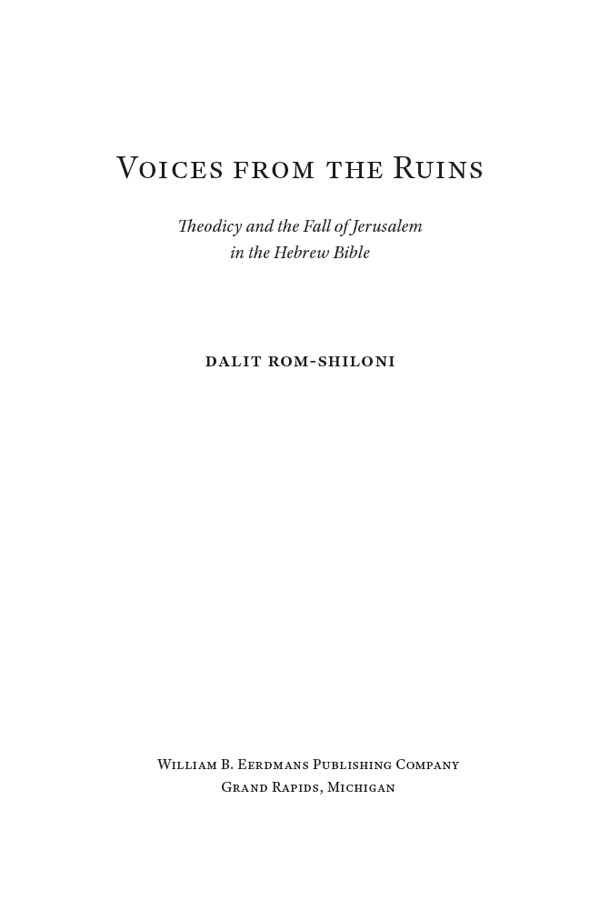
Wm. B. Eerdmans Publishing Co.
4035 Park East Court SE, Grand Rapids, Michigan 49546
www.eerdmans.com
2021 Dalit Rom-Shiloni
All rights reserved
Published 2021
Printed in the United States of America
27 26 25 24 23 22 21 1 2 3 4 5 6 7
ISBN 978-0-8028-7860-1
Library of Congress Cataloging-in-Publication Data
Names: Rom-Shiloni, Dalit, author.
Title: Voices from the ruins : theodicy and the fall of Jerusalem in the Hebrew Bible / Dalit Rom-Shiloni.
Description: Grand Rapids, Michigan : William B. Eerdmans Publishing Company, 2021. | Includes bibliographical references and index. | Summary: An examination of the Hebrew Bibles theological discourse in the face of the catastrophic events of the Neo-Babylonian exiles and the destruction of the Jerusalem templeProvided by publisher.
Identifiers: LCCN 2020046889 | ISBN 9780802878601 (hardcover)
Subjects: LCSH: TheodicyBiblical teaching. | Bible. Old TestamentTheology. | GodBiblical teaching. | Providence and government of GodJudaism. | Temple of Jerusalem (Jerusalem)
Classification: LCC BS1199.T44 R67 2021 | DDC 231/.8dc23
LC record available at https://lccn.loc.gov/2020046889
To the blessed memory of Talia Abramovitz-Zwebner, wishing strength to her loving family and friends
C ONTENTS
PART 1
QUESTIONS OF METHOD
PART 2
THEODICY AS DISCOURSE IN THE FACE OF DESTRUCTION
P REFACE
This study grows out of many years spent in the company of the biblical writings from the time of the destruction and exiles, during which time I was able to elucidate a number of the complex issues at stake for this corpus.
My previous work suggested that an ideal first target for the development of such a methodological approach would be precisely the literature of the critical sixth century BCE. My continuing focus on this period offered the advantage of a demarcated body of sources for such a descriptive project. The most significant development suggested in this book is my advancement of theodicy as discourse as the rubric by which we may seek to understand the interplay of ideas in the sixth century.
This book is divided into two parts. establishes the methodological foreground of the entire project, addressing four major tasks.
presents the overall theological theme of theodicy as discourse. The modern definition of theodicy as justification of God, commonly accepted by both Jews and Christians, is shown to be less than satisfactory for an understanding of the Hebrew Bible on its own terms. Instead, the chapter articulates a notion of theodical discourse as the framework that best suits the interplay of voices with shared and diverging viewpoints.
lays the foundation for the broader discussion of Hebrew Bible theology and builds the framework for a descriptive theological study. In search of methodological principles for studying the theologies of the Hebrew Bible, this chapter reveals a controversy between Christian and Jewish scholars (and theologians), as well as among Jewish scholars of Hebrew Bible theology as to what constitutes the proper aim, principles, and content of Hebrew Bible theology.
describes the multiplicity of voices and the diversity of thought within the target corpora. Each section of this chapter outlines common scholarly approaches to the sources, challenges them, and sets out an alternative approach. An overarching methodological question is whether conceptualizing these sources as reflective of social or cultural dichotomies of different sortsofficial and unofficial voices, orthodox and nonorthodox stances, or core and peripheral attitudesis the most helpful approach to the description of the theological polemics seen in these sources. I suggest that theodical discourse is a more fruitful way to understand the polysemy of theological perspectives that form a discourse among equals. The presentation of the biblical sources allows me to further challenge traditional literary-historical approaches and to suggest an alternative, more complex methodology that takes into consideration both literary approaches and trauma studies. Such a methodology allows both synchronic and diachronic dimensions into the study of these theological reactions to the catastrophe.
summarizes the previous methodological discussions and consolidates a proposition for a Tanakh/Hebrew Bible theology based on the shared conception of God as king.
focus on God as judge. Each chapter sets out the conceptual grounds that constitute the shared theological heritage and points of departure for the internal polemics concerning Gods role in the catastrophes of the sixth century. Closer study of our sources reveals the plurality of sixth-century religious thought and enables a careful look into the interrelationships between the antagonists. The analysis of each complex of images concerning Gods roles as king rotates through the three modes of the theodical discourse: justification, doubt, and protest.
Next page

